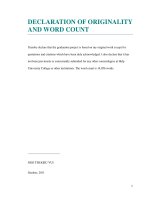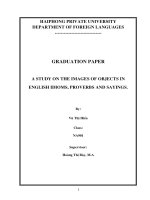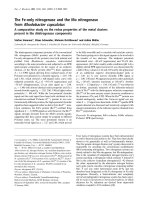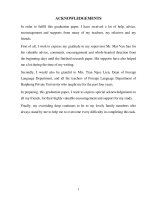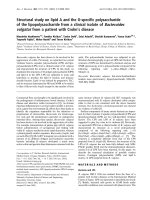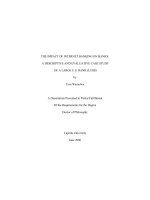A study on the sounds of vowels and consonants in English
Bạn đang xem bản rút gọn của tài liệu. Xem và tải ngay bản đầy đủ của tài liệu tại đây (761.86 KB, 67 trang )
1
ACKNOWLEDGEMENTS
In order to fulfill this graduation paper, I have received a lot of help, advice,
encouragement and supports from many of my teachers, my relatives and my
friends.
First of all, I wish to express my gratitude to my supervisor Mr. Mai Van Sao for
his valuable advice, comments, encouragement and whole-hearted direction from
the beginning days until the finished research paper. His supports have also helped
me a lot during the time of my writing.
Secondly, I would also be grateful to Mrs. Tran Ngoc Lien, Dean of Foreign
Language Department, and all the teachers of Foreign Language Department of
Haiphong Private University who taught me for the past four years.
In preparing, this graduation paper, I want to express special acknowledgements to
all my friends, for their highly valuable encouragement and support for my study.
Finally, my overriding deep continues to be to my lovely family members who
always stand by me to help me to overcome every difficulty in completing this task.
2
TABLE OF CONTENTS
Acknowledgements
PART I: INTRODUCTION Page
1.
Rationale of the study
1
2.
Aims of the study
2
3.
Scope of the study
2
4.
Methods of the study
2
5.
Design of the study
3
PART II: DEVELOPMENT
CHAPTER I: THEORITICAL BACKGROUND
I.
INTRODUCTION ON PHONEME, PHONETICS
AND PHONOLOGY
4
1.
Definition of phoneme
4
2.
Definition of phonetics & phonology
4
3.
Difference between phonetics & phonology
5
II.
THE PRODUCTION OF SPEECH SOUNDS
5
1.
Articulators above the larynx.
5
3
2.
Vowels
7
3.
Consonants
13
CHAPTER II: VARIATIONS OF VOWELS AND CONSONANTS IN
SPEECH ENGLISH
I.
PRINCIPLES OF VOWELS PRONONCIATION
17
1.
Mono-vowels
17
2.
Diphthongs
28
3.
Triphthongs
38
II.
PRINCIPLES OF CONSONANTS PRONONCIATION
39
1.
Single consonants
39
2.
Double consonants
44
3.
Silent consonants
46
CHAPTER II: FINDINGS AND IMPLICATION
I.
FINDINGS
54
II.
IMPLICATION
57
PART III: INCLUSION 59
REFERENCES
EXERCISES
4
PART I: INTRODUCTION
1. Rationale of the study
In order to speak English more exactly, specialists devised an international
phonetic symbols for people who want to learn and speak English more easily and
more quickly because learning a foreign language is based on the international
phonetic alphabet ( IPA) which can help them pronounce and speak English more
accurately like truly native speakers. However, today there are so many different
systems of the phonetic symbols corresponding to each individual country in the
world. For example, Vietnam also has its owned phonetic symbols along with
Vietnamese language and voice. In all of those phonetic methods, only the
International Phonetic Alphabet is used most conveniently and most popularly.
In fact, according to researched statistics, the majority of English learners in
Vietnam who don‟t often have a using habit of this IPA because they still think that
using their personally Vietnamese phonetic symbols is considered the most
convenient & most easy way to learn a foreign language. This is truly a big mistake
because using their mother tongue‟s phonetic symbols can‟t rewrite exactly the
words that they hear. For example, when learners want to pronounce the „MAP‟
word in English, if they use their Vietnamese phonetic symbols to copy the sound
of the „Map‟ word they will write it into the „mép‟ word in Vietnamese. Actually,
native speakers don‟t speak that word completely the same way as the Vietnamese
phonetic symbols like the „mép‟ of the „mồm mép‟ word in Vietnamese. So,
learners should speak the „map‟ word is the „ma+ép‟ or the „ma+ẹp‟ according to
similarly Vietnamese speaking.Your communication can be a success or a
breakdown which can be due to your grammar or vocabulary mistakes but
sometimes due to your phonetic ones. Therefore, a study on the sounds of vowels
and consonants in English has been one of my big concerns that have become one
of the main reasons motivating me to carry out this research.
5
2. Aims of the study
For the purpose of pointing out the principles of vowels and consonants
pronunciation in speech English, my study focuses on:
Introducing theorical background about phoneme, phonetics & phonology, the
production of speech sounds and the study on vowels & consonants in speech
English.
Particularly, giving the principles of vowels & consonants pronunciation may make
learners try to speak like native speakers in English communication.
Indicating the findings and implication, proposing some suggestions.
Providing some exercises may be very helpful for learners in English pronunciation
as well as in English communication today.
3. Scope of the study
A properly English speaking and pronunciation is an extremely large study,
including researching for principles of vowels & consonants pronunciation,
mentioning to principles of recognizing the word stress or discussing the
intonation of a sentence etc… However, due to the limit of time and knowledge,
the writer don‟t have ambition to study all the matters relating to speech English
.As mentioned above, in this paper, only study on the sounds of vowels &
consonants in English are presented and analyzed. Especially, the writer pays much
attention to principles of vowels & consonants pronunciation for learners‟ English
speaking & communication.
4. Methods of the study
To achieve the aims of the study successfully & effectively, in my studying
process, I stored knowledge from a lot different kinds of resources specialized in
the sounds of vowels & consonants in English. This study is fulfilled due to the
information collected from different resources to give the theorical background
6
such as introduction about phoneme, phonetics & phonology. Then, an analysis on
the production of speech sounds is carried out as pointing out definition,
classification & description of the sounds, giving out the principles of the sounds‟
pronunciation. After that, the implication is referred for a better English speaking &
communication. Finally, there come suggestions for further study.
5. Design of the study
My graduation paper consists of 3 main parts of which the second part_ the
development is the most important one.
Part I: Introduction, which indicates the rationale, the aims, the scope, the
methods & the design of the study.
Part II: Development mentions the main content of the study and it is further
divided into 3 chapters as below:
Chapter1: is called “Theorical background” in which the introduction on
phoneme, phonetics & phonology (definition, difference, importance of them), the
production of speech sounds (introduction on articulators above the larynx, vowels
& consonants) are presented.
Chapter2: namely variations of vowels & consonants in speech English, deals with
the 2 following matters: The principles of vowels pronunciation & the principles of
consonants pronunciation.
Chapter3: Pointing out the findings and implication as well as some suggestions
for using the English pronouncing principles in order to gain a better English
communication.
Part III: Conclusion gives a brief summary of the study and suggestion for further
study.
Besides, the writer would like to state herein the appendix in which some exercises
of English word pronunciation are presented.
7
PART II: DEVELOPMENT
CHAPTER I: THEORITICAL BACKGROUND
I. INTRODUCTION ON PHONEME, PHONETICS AND PHONOLOGY
1. Definition of phoneme:
“Phoneme _ the smallest phonetic unit in a language that is capable of conveying a
distinction in meaning, as the /m/ of “mat” and the /b/ of “bat” in English”
(Jones: 1950)
“Phoneme_ the smallest sound unit in a language that is capable of conveying a
distinct meaning, such as the/s/ of “sing” & the /r/ of “ring” in English”
(Abercrombie: 1967)
“Phoneme (linguistics) _ one of the small set of speech sounds that are
distinguished by the speakers of a particular language”.
(Gimson: 1962)
2. Definition of phonetics & phonology:
“Phonetics” is the study of sounds (voice). It is concerned with the actual
properties of speech sounds (phones) as well as those of non-speech sounds and
their production, audition & perception, as opposed to phonology, which operates
at the level of sound systems & abstract sound units such as phonemes &
distinctive features.
“Phonetics” deals with speech sounds themselves, how they are made (articulator
phonetics), how they are perceived (auditory phonetics) & the physics involved
(acoustic phonetics).
(Abercrombie: 1967)
“Phonology” is a subfield of linguistics which studies the sounds systems of a
8
specifics language .Phonology describes the way sounds function within a given
language or across languages.
“Phonology” deals with how these speech sounds are organized into system for
each individual language; for example, how the sounds can be combined, the
relations between them, and how they are affect each other.
(Gimson: 1962)
An important part of phonology is studying which sounds are distinctive units
within a language and studies how sounds alternate. For example: The/p/ in “pin”
is aspirated while the same phoneme in “spin” is not.
3. Difference between phonetics & phonology.
“Phonetics” simply describes the articulatory & acoustic properties of phones
(speech sounds).
“Phonology” studies how sounds interact as a system in a particular language.
In the other ways, “Phonetics” studies which sounds are present in a language,
“Phonology” studies how these sounds combine and how they change in
combination, as well as which sounds can contrast to produce differences in
meaning or “Phonology” describes the phones as allophones of phonemes.
II. The production of speech sounds:
1. Articulators above the larynx:
All the sounds we make when we speak are the result of muscle contracting. We
have a large and complex set of muscles that can produce changes in the shape of
the vocal tract, and in order to learn how the sounds of speech are produced it is
necessary to become familiar with the different parts of the vocal tract. These
different parts are called “articulators”.
9
Diagram of articulators above the larynx.
The articulators that can‟t move are called “the passive articulator” (teeth,
alveolar ridge…)
The articulators that can move are called “the active articulators “(epiglottis,
tongue, lips…)
1.1. The pharynx: Is a tube which begins just above the larynx. It is about 7 cm
long in woman and about 8 cm in men, and at its top end it is divided into 2, one
part being the back of the mouth and the other being the beginning of the way
through the nasal cavity.
1.2. The velum or soft palate: Is a part that allows air to pass through the nose and
through the mouth. Yours is probably in that position now, but often in speech it is
raised so that air can‟t escape through the nose.
The other important thing about the velum is that it is one of the articulators that
can be touched by the tongue. For example, when we make the sounds /k/ and /g/,
the tongue is in contact with the lower side of the velum and we call /k/ and /g/
velar consonants.
1.3. The hard palate: Is often called the “roof of the mouth” you can feel its
smooth curved surface with your tongue.
10
1.4. The alveolar ridge: Is between the top front teeth and the hard palate you can
easily feel its shape with your tongue. Its surface is really much rougher than it
feels, and is covered with little ridge. Almost sounds are made with the tongue
touching the alveolar ridge. For example: When you make the sounds /t/ and /d/,
these sounds are called alveolar consonants.
1.5. The tongue: Is a very important articulator and it can be moved into many
different places and different parts like tip, blade , front, back, and root of the
tongue.
Figure of tongue blade
1.6. The teeth upper and lower: Are shown in diagrams. Almost speakers have
teeth to the sides of their mouths, back almost to the soft palate. The tongue is in
contact with the upper side teeth for many speech sounds made with the tongue
touching the front teeth are called dental consonants like: / θ/, /ð /.
1.7. The lips: Are important in speech. They can be pressed together when we
produce the sounds /p/, /b/, brought into contact with the teeth (as in /f/, /v/) or
rounded to produce the lip – shape for vowels like /u:/.Sounds in which the lips are
in contact with each other are called bilabial like /p/, /b/, /m/, while those with lip –
to – teeth contact are called labiodentals like /f/, /v/.
2. Vowels
2.1. Definition of Vowels:
a. Monophthongs:
11
Monothhongs (short vowels) are sounds in the production of which there is no
obstruction to the flow of air as it passes from the larynx to the lips .They are
usually pronounced with the vibration of the vocal cord.
b. Diphthongs:
Diphthong is a sound consisting of a movement or a glide from one vowel to
another. In terms of length, diphthong is considered as long vowels and the first
part in a diphthong is longer than the second.
c. Triphthongs.
A triphthong is a glide from one vowel to another and then to a third, all produced
rapidly and without interruption.
2.2. Classification of vowels:
There are 20 vowels in English sound system including 12 pure vowels & 8
diphthongs plus 5 triphthongs.
*Monothongs:
/i/: sit, kiss /æ/: cat, bad
/e/: bed, pet / ʊ/: put, soot
/ ə/: hammer, teacher / ʌ/: cut, shut
/ɒ/: hot, sport /i:/: seat, see
/u:/ : school, spoon /a:/: car, father
/ɔ:/ : sport, floor /ɜ:/ : heard, girl
Monophthongs are classified according to 3 criteria:
According to the height of the tongue:
12
High vowels: / i:, i , ʊ, u: /
Middle vowels: / e,ɔ, ɜ:, ə/
Low vowels: / æ, ʌ, ɒ,a:/
According to the front /back of the tongue:
Front vowels: / i:, i, e, æ/
Central vowels: /ʌ, ɜ:, ə/
Back vowels: /ɒ, u:, ʊ, ɔ:,a:/
According to the lips rounding:
Rounded vowels: /ɒ, u:, ʊ, ɔ:/
Unrounded /spread vowels: /ʌ, ɜ:, ə,a/
Neutral vowels:/e,i, i:,æ/
Diagram of vowels classification
*Diphthongs:
/i ə/: beard, fiece /eə/: aried, scarce
13
/ʊə/: moored, tour /ei/ paid, face
/ai/: tide, nice /ɔi /: void, voice
/əʊ/: load, most/ aʊ/ : loud, house
Diphthongs can be classified into 2 groups: Centring diphthongs (ending in /ə /)
include /iə/, /eə/, /ʊə/. Closing diphthongs (ending in /i/) include /ei/,/ai/,/ɔi
/(ending in /ʊ/) include /əʊ/& /aʊ/.
*Tripthongs
The tripthongs can be looked on as being composed of the five closing diphthongs
described above with /ə / added on the end.
Thus, we get: - eiə, aiə, ɔiə, əʊə, aʊə.
2.3. Description of vowels:
a. Mono-vowels:
1. /e/: bet, men, yes …
-The tongue position is lower and moth is more open for /e/ (middle vowel), front
vowel, spread vowel
2. / æ/ bat, man, gas …
-The mouth is wide open; the tongue comes forward for/æ/(low vowel), front
vowel, spread vowel.
3. /ʌ/ but, some, rush …
-The mouth only opens a little for /ʌ/ (low vowel), front vowel, neutral vowel
4. / ɒ/ pot, gone, cross …
14
-The mouth opens a lot for /ɒ/ (low vowel), back vowel, rounded vowel
5. / ʊ/ put, full, but …
-The tongue position is closer to /ʌ/, the mouth only opens a little for /ʊ/ => (high
vowel), rounded vowel
6. /i/ bit, pin, fish …
-The tongue is pulled back and down (high vowel), front vowel, neutral vowel
7. /ə/ about, oppose, perhaps …
-The mouth only opens a little for /ə/(middle vowel), central vowel, neutral vowel
8. /i:/ beat, mean , peace …
-For /i:/ keep pushing the body of the tongue forward and spread the lips (high
vowel), front vowel, spread vowel
9. /ɜ:/ bird, fern, purse …
-The back of the tongue is bunched up & pulled back, he tip of the tongue is
slightly raised but never touches the roof of the mouth (middle vowel), central
vowel, neutral vowel
10. /a: / card, half, pass …
-The tongue comes further back for /a: / (low vowel), back vowel, neutral vowel
11. /ɔ:/ board, torn ,horse …
-The mouth is more open and the lips are only slightly rounded for/ɔ: / (middle
vowel), back vowel, rounded vowel
12. /u: / food, soon, loose …
-Push the tongue high and back and round the lips strongly for/u: / (high vowel),
15
back vowel, rounded vowel
b. Diphthongs:
1. /iə/: beard, Iran, fierce …
The starting point is a little closer than /i/ in „bit‟, „pin‟.
2. /eə/: aried, cairn, scarce …
This diphthong begins with the same vowel sound as the /e/ of „get‟. „men‟.
3. /ʊə /: moored, tour, sure …
For speakers who have this diphthong, this has a starting point slightly closer than
/ʊ/ in „put‟, „pull‟.
4. /ei /: save, pain, face …
The starting point is the same as the /e/ of „get‟, „men‟.
5. /ai/: tide, fine, cry …
This diphthong begins with an open vowel which is between front and back, it is
quite similar to the/ʌ/ of the words „cut‟, „bun‟
6. /ɔi /: void, loin, noise …
The first part of this diphthong has the same quality as /ɔ:/ in „ought‟, „born‟.
7. /əʊ/: load, home, slow …
The vowel position for the beginning of this is the same as for the „schwa‟ vowel
/ə/. The lips may be slightly round in anticipation of the glide towards /ʊ/, for
which there is quite noticeable lip- rounding.
8. /aʊ/: loud, gown, flower …
16
This diphthong begins with a vowel similar to /a: / since this is an open vowel,
glide to /ʊ/ would necessitate a large movement. Usually in English the glide
towards /ʊ/ begins but is not completed.
3. Consonants.
3.1: Definition of consonants:
A consonant is a sound in spoken language that is characterized by a closure or
stricture of the vocal tract sufficient to cause audible turbulence. So, a consonant is
the sound in the production of which one articulator moves toward another or two
articulators come together obstructing the air stream so the air stream can‟t get out
freely.
3.2: Classification of consonants: According to 2 criteria:
a. Place of articulation: Including 9 groups:
Bilabial sounds: / p, b, m, w / Labio – dental sounds: / f, v /
Dental sounds: /θ,ð / Alveolar sounds: /t, d, l, n, s, z /
Palato – Alveolar sounds:/ʃ, ʒ, tʃ, dʒ/ Velar sounds: / k, ŋ, g/
Glottal sound: / h / Retroflex sound: / r /
Palatal sound: / j /
b. Manners of articulation: Including 6 groups:
Stop/plosive sounds: /p-b/, /t-d/, /k-g/ Nasal sounds: /m, n, ŋ/
Fricative sounds: /f-v/,/θ-ð/,/s-z/, /ʃ- ʒ/, /h/ Approxamant: /r, w, j/
Affricative sounds: /tʃ, dʒ/ Lareral sound: /l/
17
3.3: Description of consonants: According to 3 criteria:
*The place of articulation:
Bilabials /b, p, m, w/ are the sounds made with 2 lips.
Labio – dentals /f, v/ are the sounds made with the lower lip and the upper front
teeth.
Dentals/θ, ð/ are the sounds made with the tip of the tongue and the upper front
teeth. The tip of the tongue nearly touches the upper front teeth.
Alveolar /t, d, n, l, s-z/ are the sound made with the tip of the tongue and the
alveolar ridge. The tip of the tongue is moved to the alveolar ridge.
Palatal /j/ are the sounds made with the front of the tongue and the hard palate.
Palatal – alveolar/ ʃ, ʒ, tʃ, dʒ / are the sounds made with the palate of the tongue
and the back of the alveolar ridge.
bilabial
labiodental
dental
alveolar
postalveola
r
retroflex
palatal
velar
glottal
plosive
p
b
t
d
k
ɡ
nasal
m
n
ŋ
fricative
f
v
θ
ð
s
z
ʃ
ʒ
h
approximant
(w)
r
j
(w)
lateral
approximant
l
affricate
tʃ
dʒ
18
Velars/k, g, ŋ/ are the sounds made with the back of the tongue and the soft palate.
Glottal /h/ is made at the epiglottis.
Retroflex /post alveolar /r/ are the sounds made with the tip of the tongue and the
back of the alveolar.
*The manners of articulations:
Stops / plosives: /p-b/, /t-d/, /k-g/
Stops are the sounds in the production of speech. The air stream is obstructed in
the oral cavity. Because of a complete closure of the articulators involved and the
soft palate is raised blocking off the nasal cavity so that the air stream escaped
strongly causing a plosure.
Nasals: /m-n, ŋ/
Nasals are the sounds made with the air stream being obstructed in the oral cavity
with the complete closure of the articulators involved but the soft palate is lowered
so that the air stream escapes through the nose.
Fricatives. /f-v/, /s-z/, /h/, /θ-ð /, /tʃ- dʒ/
Fricatives are produced where two articulators come close together but there is till
a small opening between them so that the air stream is partially obstructed and an
audible friction noise is produced.
Affricates: /tʃ-dʒ/
Affricates are produced when the stop is immediately followed by a fricative which
is hormorgnic.
Laterals. /l/
Latoral is made when the air stream is being obstructed centrally and the air stream
escaped laterally.
19
Approximants: /r,w, j/
Approximants are produced when two articulators nearly touch. The air stream is
partially obstructed but not enough to cause friction.
*According to their voicing are classified into 2 types:
*Voiceless means that the vocal folds don‟t vibrate during the production of
voiceless consonants.
*Voiced means that the vocal folds vibrate during the production of voiced
consonants.
Voice less (Fortis) like: /p, t, k/ etc.
Voiced (Lenis) like: / b, d, g/ etc.
20
CHAPTER II: VARIATIONS OF VOWELS AND CONSONANTS
IN SPEECH ENGLISH
I – Principles of vowel pronunciation:
1. MoNo – vowels:
1.1: How to pronounce “A”: “A” is pronounced into /æ/:
a. In case, the words which have only one syllable and end with 1 or more
consonants.
Ex: Lad /læd/= con trai.
Dam /dæm/ = đập ngăn nước
Slang /slæŋ / = tiếng lóng
b. In case, “A” is stressed and is in a syllable of the word which has many syllables
and stands before 2 consonants.
Ex: Candle /„kændl / = cây nến
Baptize /„bæptaiz / = rửa tội
Narrow /„nærəu/ = chật hẹp
“A” is pronounced into /ei/:
a.In case, the words which have only one syllable and have an ending way: A +
consonant + E.
Ex: Cane /kein / =cây gậy
Mate /meit / = bạn đồng nghiệp
Gate /geit / = cổng
b. In case, “A is in a syllable of the word standing next to the other syllable which
ends with “ – ion” or “ – ian”.
21
Ex: Nation /„neiʃən /= quốc gia
Translation /„trænsleiʃən/ = bài dịch
Liberation /libə„reiʃən / = sự giải phóng
But: Mansion /„mænʃən/ = lâu đài
Companion /„kəmpæniən /= bạn đòng hành
Italian /„itæliən/ = người Ý
“A” is pronounced into /ɔ: /
a. In case, the words which only have one syllable and end with “ll”.
Ex: All /ɔ:l/ = tất cả
Call /kɔ:l /= kêu gọi
Small /smɔ:l / = nhỏ bé
But: Shall /ʃæl / = phải sẽ
“A” is pronounced into /ɔ/:
a.In case, the words which have one stressed syllable or begin with “w” semi –
vowel
Ex: Was /wɔz/ = quá khứ của “tobe”
Wand /wɔnd / = đũa thần
Watch /wɔtʃ/ = đồng hồ
But: Way /wei /= con đường
22
Waste /weist / = hoang phí
Wag /wæg / = ngoe nguẩy
“A” is pronounced into /a:/
In case, the words have one syllable which end with “R” consonant or with “R +
another consonant”, orinone syllable of word when “a” stands before “R + another
consonant”.
Ex: Bar /ba:/ = thanh dài
Star /sta:/ = ngôi sao
Barn /ba:n/ = vựa thóc
But: Scarce /skɜəs/ = khan hiếm
Half /ha:f / = 1 nửa
Quart /kwɔ:t / = một lit Anh (=1 lít 135)
Sparrow /„spærəu/ = chim sẻ
“A” is pronounced into /ɜə/:
In case, the words have “A” standing before “R” consonant.
Ex: Prepare /„pripɜə/ = sửa soạn
Harem /„hɜərəm /= khuê phòng
Garish /„gɜəriʃ/ = loà loẹt
But: are /a:/= động từ tobe
“A” is pronounced into /i/:
“A” is pronounced end with “ate” and two syllables – nouns end with “age”.
23
Ex: Deliberate /di„libərit / = đắn đo
Village /„vilidʒ /= làng xã
Cottage /„kɔti dʒ /= nhà tranh
Damage /„dæmidʒ/ = thiệt hại
“A” is pronounced into /ə/:
In case, the syllable of the word isn‟t stressed.
Ex: Separate /„sepəreit/ = ngăn cách
Explanation /eksplə„neiʃən/ = sự giải thích
National /„næʃən/= có tính quốc gia
But: magnanimous /mæg„næniməs/ = quảng đại
Kitchen /„kitʃən/or /„kitʃin/ = cái bếp
1.2: How to pronounced “E”:
“E” is pronounced into /e /:
In case, the words have only syllable and with 1 or more consonants except for
“R”, or in the stressed syllable of the word.
Ex: Bed /bed / = cái giường
Them /ðem / = chúng nó
Member /„membə/= thành viên
Extend /ik„stend / = mở rộng
But: Her /hə: /= cô ấy
Term /tə: m/ = thời hạn
24
Interprete /intə„pri:t / = thông ngôn
“E” is pronounced into /i:/ :
In case, “E” stands before the words like “de”, “ne ”, “te”, “se”…or has the ending
method of the word is consonant + e.
Ex: Cede /si:d /= nhượng bộ
Compelete /„kəmplit /= hoàn toàn
Vietnamese /„vietnəmi:z /= người Việtnam
“E” is pronounced into/[i/:
In case, “E” is in the prefix of the word such as “be”, “de”, “re”, “etc”.
Ex: Begin /„bigin / = bắt đầu
Behave /be„hæv/ = cư xử
Remind /ri„maind/= nhắc nhở
Reorganize /ri„ɔ:gənaiz/ = tổ chức lại
“E” is pronounced into /ə/:
In case, “E” is in the unstressed syllable of the word.
Ex: Silent /„sailənt/ = im lặng
Open /„oupən/ = mở ra
Chicken /„tʃikən/ = gà con
Punishment /„pʌniʃmənt/ = sù trừng phạt
1.3: How to pronounce “I”
“I” is pronounced into /ai /:
In case. The words have their ending is i + consonant + e
25
Ex: Bite /bait / = vết cắn
Site /sait / = địa điểm
Like /laik / = ưa thích
But: To live /liv /= sống
To give /giv/ = cho, ban cho
“I” is pronounced into /i/:
In case, the words have one syllable and end with “ i + consonant “.
Ex: Bit /bit / = miếng nhỏ
Din /din/ = tiếng ồn ào
Twin /twin/ = song sinh
Him /him / = ông ấy
“I” is pronounced into /i:/
In case, “I” is in some words which descend of French
Ex: Machine /mə„ʃi:n / = cái máy
Regime /rei„ʒi:m/ = chế độ ăn uống
Mandoline /mændə„li:n / = đàn măng cầm
Routine /ru„ti:n/ = công việc hàng ngày
1.4 How to pronounced “O”.
“O” is pronounced into /oʊ/:
a. In case, “O” stands at the word.
Ex: No /noʊ /= không


